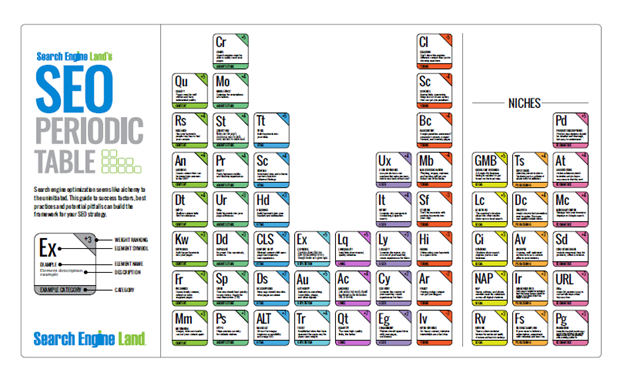
SEO aims to improve the ranking of your website in the search results.
But the success of your SEO depends on some key factors or signals required by a search engine from your website.
Some key signals are content, user experience, site architecture, links and reputation. All these ranking factors must work together.
This is what the SEO Periodic table is all about. It includes all important signals as well as warning signs to help make SEO successful.
Whether you are an experienced SEO pro or a beginner, the SEO periodic table is useful for every webmaster. It is a quick glance at the essential SEO signals required to make a website successful.
It is much like a periodic table we have studied in chemistry classes which includes all the chemical elements in order of atomic number. SEO is also complex chemistry to create the right signals search engines are looking for.
Basically, it is a chart that has listed important SEO ranking factors.
Here we will understand everything about the periodic table of SEO.
(Note: All images used in this content have been sourced from Search Engine Land.)
What is the Periodic Table of SEO?
The SEO Periodic Table was launched by Search Engine Land in 2011. Since then, it has been recognized by SEO professionals worldwide. The table includes several SEO factors that can improve the ranking of a website. In other words, SEO Periodic table helps you find the best SEO practices. In 2021, Search Engine Land has updated some new features in the table.

(Image source: Search Engine Land)
What Does the SEO Periodic Table Include?
You must have understood that the SEO periodic table shows important “ranking factors” and best SEO practices. Like I have said before, all these ranking factors need to work together as no single factor guarantees success.
The SEO periodic table has been organized into six positive groups—Content, Architecture, HTML, Reputation, Links and User. Each group contains certain elements.
For example—
- Content Group includes Quality, Research, Answers, Depth, Multimedia, Keywords and Freshness
- Architecture Group includes Crawl, Mobile First, Structure, Parity, URLs, Duplicate, Speed and HTTPS
- HTML Group includes Titles, Schema, Headings, Alt Image, Descriptions and Content Shift
- Reputation Group includes Expertise, Authority and Trust
- Links Group includes Link Quality, Anchors, and Quantity
- User Group includes User Experience, Intent, Locality, Country and Engagement
Then, these elements are weighted or scored differently in the periodic table. The scoring section is on the top right hand of the icon as you can see in the image below.
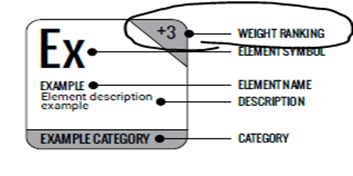
(Image source: Search Engine Land)
The scores run from +1 to +5 on the positive side and -1 to -5 on the negative side. Each element has a certain weighting or point. Some have a +1 score while some have +5. An element with a score of +1 wouldn’t be as impactful as the one that is weighted at +5.
The SEO Periodic table also includes Toxins that are negative SEO practices you should avoid. These toxins are usually weighted with “negative marking” such as A -5 (minus 5). An element with -1 won’t be as harmful as an element with a -5 point.
Understanding Each SEO Periodic Table Group and Their Elements
As I have told you that the SEO periodic table has been divided into six positive groups—Content, Architecture, HTML, Reputation, Links and User. Each group contains certain elements. There is also a negative group called Toxins in the table. These groups are basically the guidelines you should consider.
CONTENT:
Content does matter—and it matters a lot. Google’s Panda algorithm penalizes the website for inferior, shallow and thin content. Therefore, it is important to develop in-depth, high-quality content so that your website can be rewarded by a search engine.
To write quality content, make sure to do keyword research to identify the needs of your target audience. They should be well written to ensure value to the users. Keep the content updated and support your content using images and video.
Last but not least—try to write content in “question-answer” format so that it can appear as a snippet in the search results when anyone uses the same term or as a voice search result.
The above-given image shows the important CONTENT elements to consider.
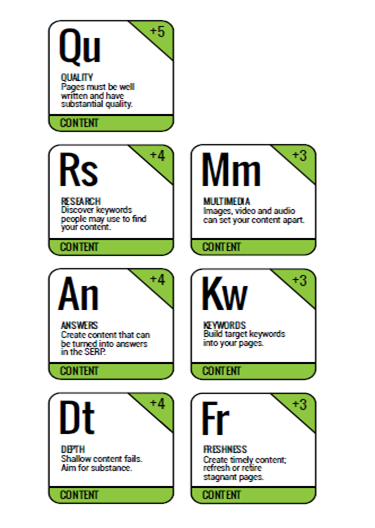
(Image source: Search Engine Land)
Architecture:
The built of your site tells search engines about what your pages are about as well as the loading speed and safety.
Some of the important elements of your site architecture are URLs, page load speed, security and crawl-ability.
If your site is not able to be crawled or indexed by a search engine, you won’t be appearing in the search results. You also need to make sure that your website is mobile responsive, meaning that it can look good on mobile devices. Setting up canonical URLs are equally important to deal with duplicate content.
You also need to work on the structure of your site so that search engine know how to navigate your website. Parity is another important element to ensure that your site offers the same user experience no matter what device is used to view it.
Make sure that your site uses HTTPS to make users feel secure enough to submit their personal information.
In a nutshell, you need to work on the elements given in the image below.
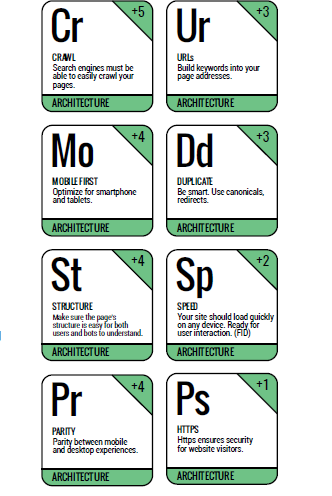
(Image source: Search Engine Land)
HTML:
The HTML tags are used to send hints to search engines about your content. Whether you are showing movie show-times, ratings or reviews or headline of your articles, you need to use HTML in every case.
Search engines prefer familiar formatting elements like Titles and Headings to figure out what your page’s content is all about and make sure that this content works well for the users.
Some other fields used by search engines are Schema, Descriptions, Image Alt, and Content Shift.
Go through the image given below to find out the important elements covered by the HTML category in the SEO Periodic Table.

(Image source: Search Engine Land)
Reputation:
Reputation is another important factor that is determined by EAT—Expertise, Authoritativeness and Trustworthiness. EAT is a method used by Google to determine the value and relevance of sites. Although EAT is not an official ranking factor, it tells Google about the reliability and authority of your site.
To build a reputation for your site, you need to work over the elements given in the image below.
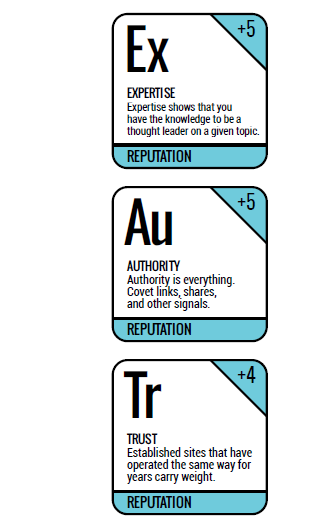
(Image source: Search Engine Land)
Links:
Links have been a traditional Google ranking factor.
The higher link quality can benefit your SEO efforts. You need to work on Anchors that are used by other sites when linking to your site. However, linking can be more beneficial if your site is linked to high-quality sites.
Keeping this in mind, the image shows some important elements that can boost your links.
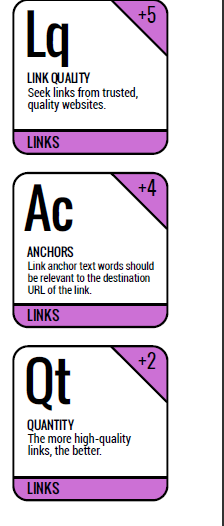
(Image source: Search Engine Land)
User:
User is an important factor in the SEO periodic table. It impacts your ranking in a particular nation or locality. For instance, the content and language (hreflang) of your site make them specific to a particular country.
You need to include the towns or neighbourhoods your serve. User interaction is also important here. Besides, you need to make sure that your pages meet the user intent as well as are engaging.
The image shows some important elements of the User Group you should consider.
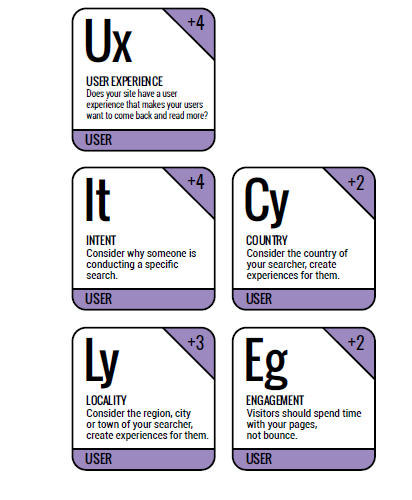
(Image source: Search Engine Land)
TOXINS—What You Should Avoid While Doing SEO
Those six groups tell you what to do to improve the ranking of your website in search results.
Here come the things you should avoid. These things can hurt your ranking. That’s why they are called TOXINS in the periodic table. Some of the popular examples of toxins or negative SEO are keyword stuffing, stolen content, unsafe content, and manipulating the search engine’s crawlers.
Toxins are the negative SEO practices, tricks or shortcuts to gain ranking. They might work unless you are tracked. But you should stay away from such negative SEO tactics as they can harm your ranking sooner or later.
The image contains such TOXINS or bad SEO practices you should avoid. There is a negative marking for each bad SEO practice.
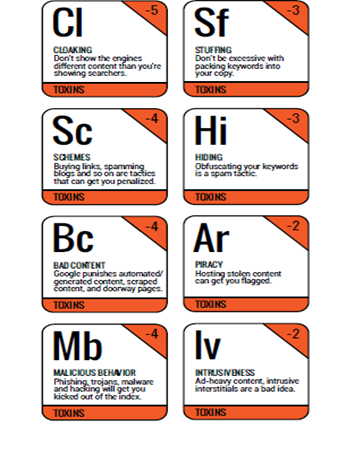
(Image source: Search Engine Land)
Also, Understand the Latest Changes in the SEO Periodic Table
The latest version of the SEO Periodic table has come with three new categories—Local, Publishing and E-Commerce. These categories have been termed as niches in the table.
Let’s have a brief overview of each niche in the SEO Periodic Table.
LOCAL:
Local SEO enables your site to appear in the local map packs. This requires NAP and a complete GMB profile. Reviews are also important. Refer to the image given below to find out what you need to ace the local SEO factor.
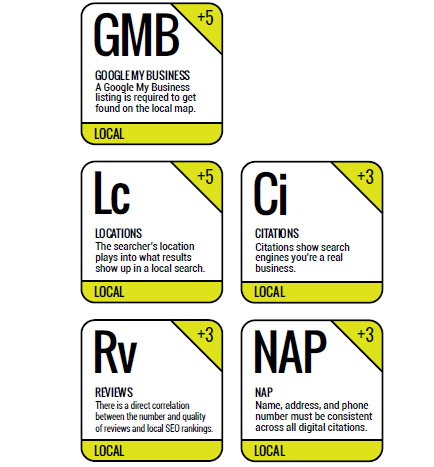
(Image source: Search Engine Land)
Publishing:
A publishing site like a news portal generates a massive amount of content every day. Therefore, it is important to archive them in order. Then, a News page is required to have at least one image.
In short, you need to work over the things mentioned in the image given below.
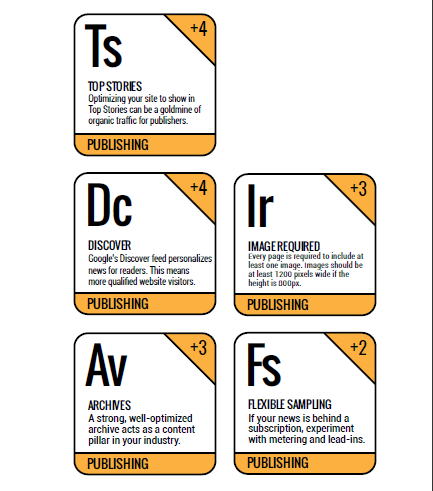
(Image source: Search Engine Land)
Ecommerce:
If you own an online store, this ranking signal is important for you. There are many factors to consider in this context. First of all, make sure your Product Descriptions are detailed while your Product Architecture is intuitive. Besides, keep your Structured Data updated for products, offers and reviews.
The below-given image will tell you how to optimize your eCommerce site for ranking.
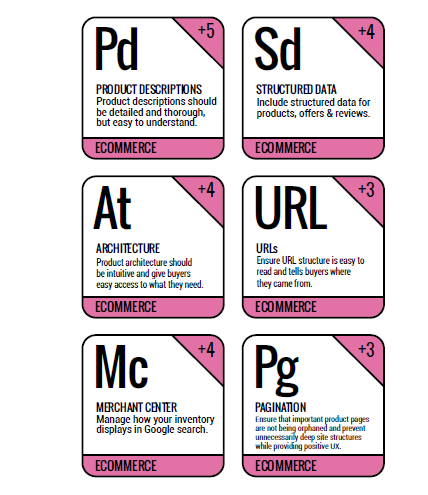
(Image source: Search Engine Land)
The Bottom Line:
SEO is not a fluke. Neither is it a matter of luck. It is all about creating quality content; improving your site performance; building links to trusted sites; using the right keywords and above all, avoiding malicious tactics to gain ranking. With the help of SEO Periodic Table, you can make sure that you have ticked all the boxes.
Wait no more and stick the printout of the SEO Periodic Table to your work desk.
What do you think? Let me know by commenting below!

Started working as a digital marketing expert, Varun Sharma is now also a well-known digital marketing speaker – a speaker on performance development, and a trusted mentor to businesses in the digital world. His keynote expositions are based on the digital marketing theories, which provide a fascinating insight into the secrets of high performance.

